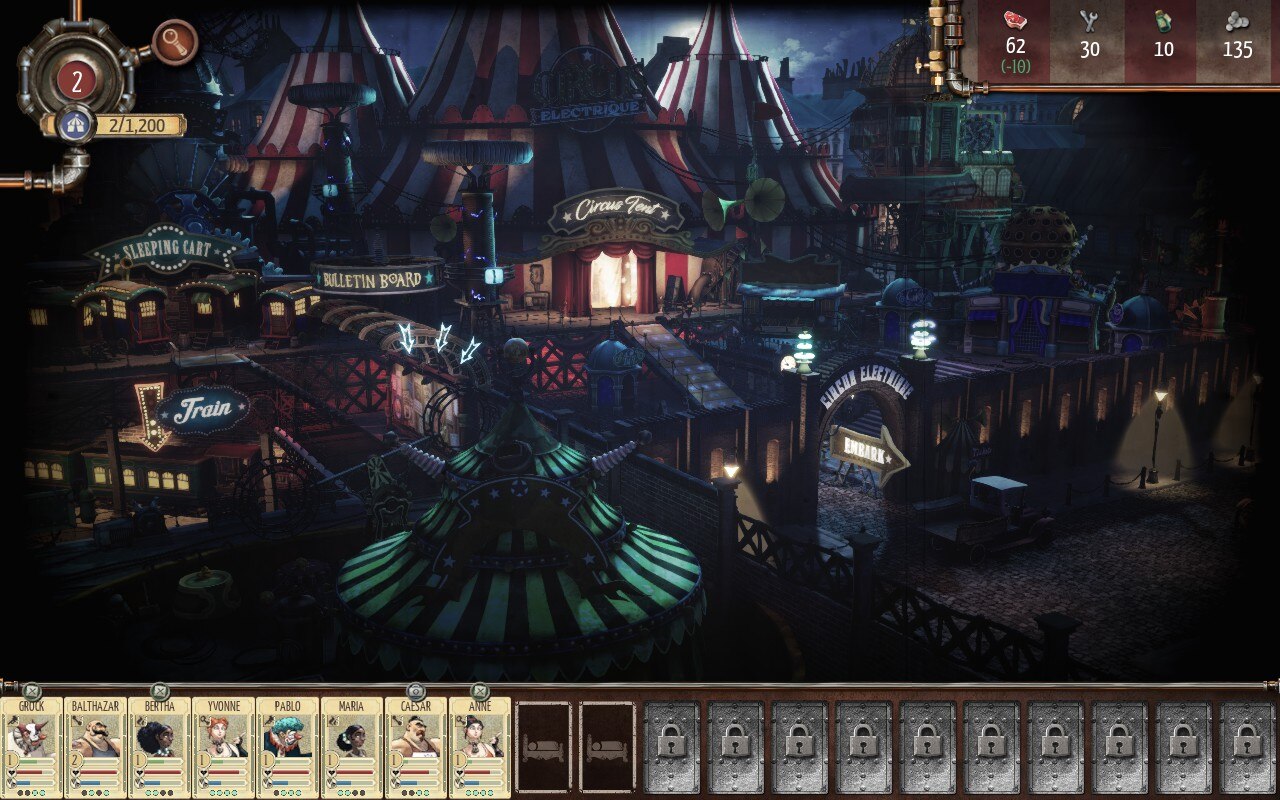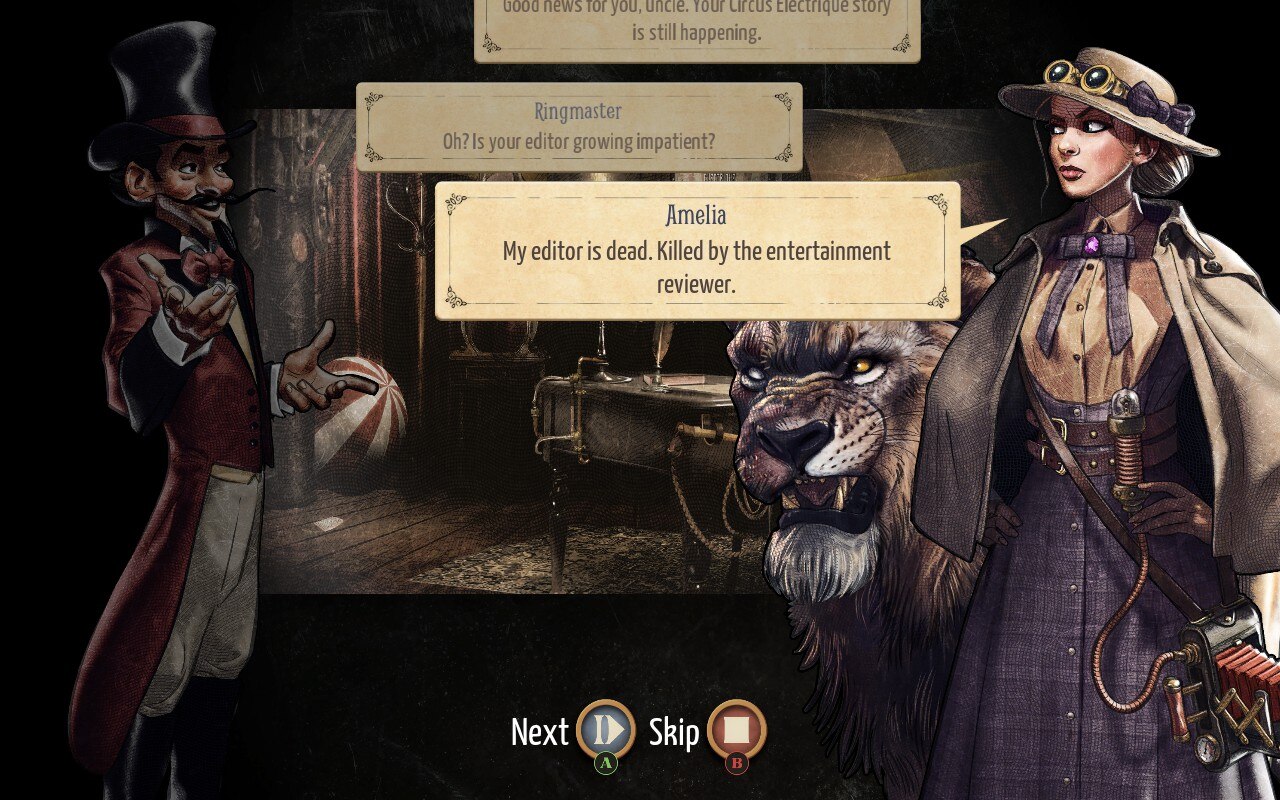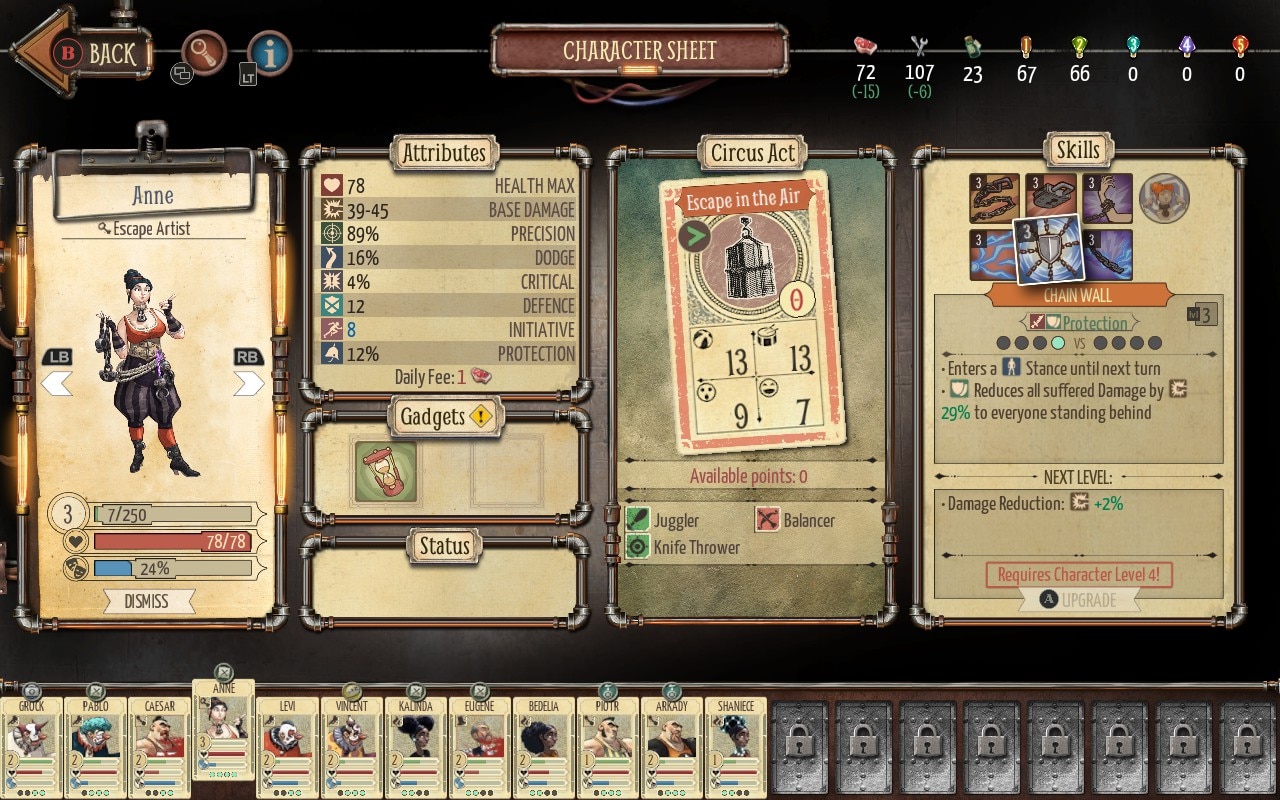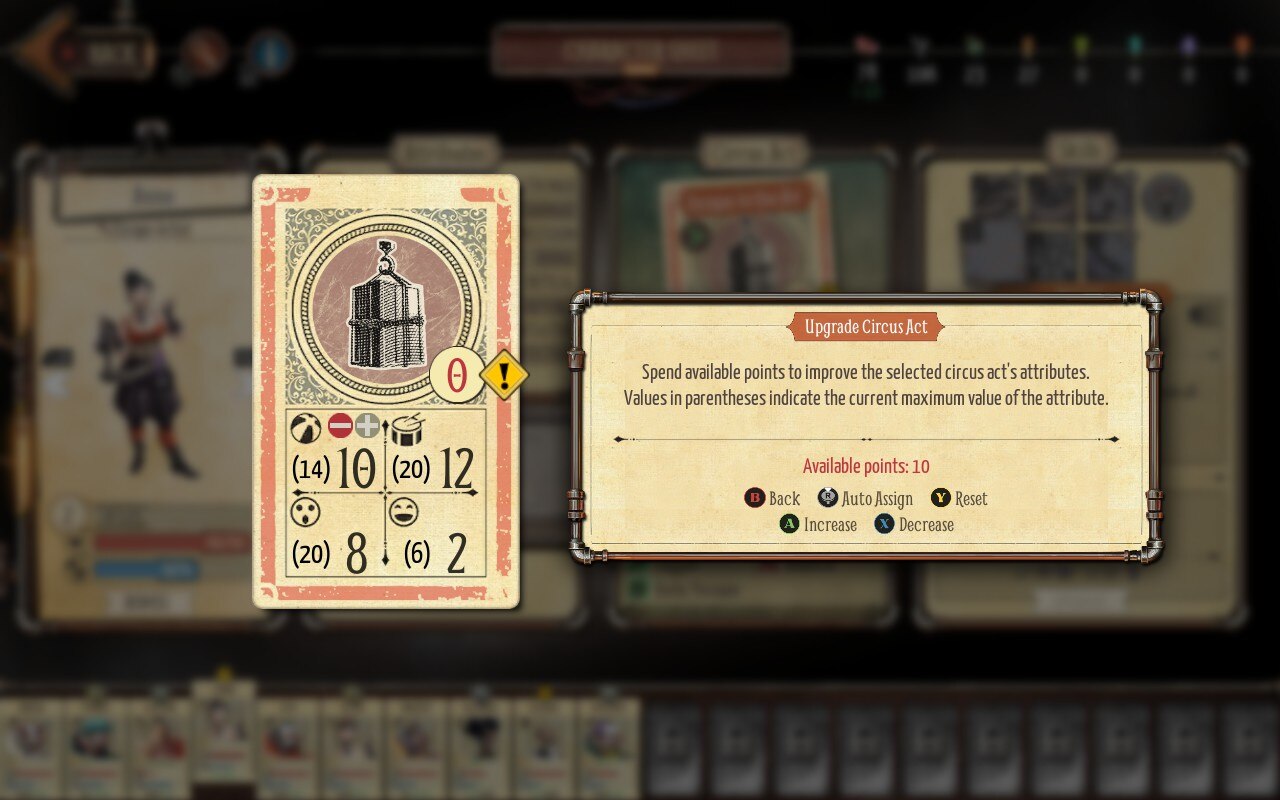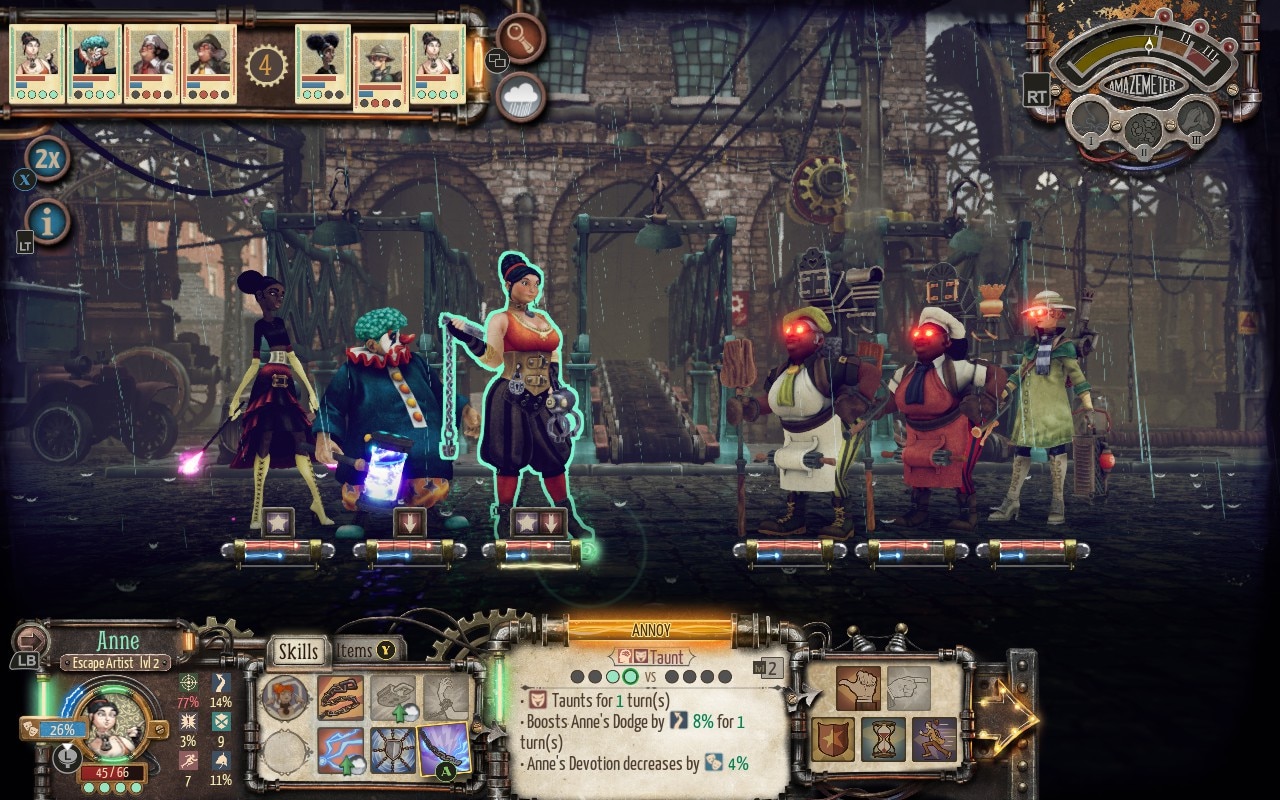Circus Electrique Review
Victorian steampunk England, where crazed police and hooligans roam the streets after some sort of mind control device goes haywire, with only some clowns, fire dancers, and other circus performers standing in the way of all out chaos. Oh, and the show must go on: these very same performers have to keep the crowds entertained to put food in their bellies and bandages on their wounds from fighting the good fight.
That’s the world of Circus Electrique, a new tactics, management, and story-driven game from developer Zen Studios. (Before this looks like they developed a lot of…pinball games?) It is a game with a lot going on, as you might expect from this brief description. The core gameplay is driven by the story of a mysterious craze that has come over London. And the core elements of the game are managing your circus performers to put on a good show for the audience (selecting who will perform and trying to maximize the material return) while also exploring and battling your way through the enemies that have run amok throughout the city.
Let’s start with one of the strongest elements, the overall presentation and production of Circus Electrique. The (linear) story is told through excellent voice acting and clean, cartoon/sketch-like, artwork. There are occasional cutscenes, mostly static art with voiceovers, as well as frequent dialogues, once every couple of days in-game. It fits well with the steampunk setting and has just the right amount of over-the-top style and acting. This is a game that understands having some more distinct look or style with the art direction is more important than the latest effects or anything gimmicky. The 3d characters in battles are also well varied with some nice animations and effects.
The story is not your typical setting, what with circuses being pretty underrepresented as the main attraction, I would say. (The one that pops to mind is the ill-fated but excellent show Carnivàle about a Dust Bowl era traveling carnival with religious mystery.) The characters are all presented with charm, the main ones with backstory, relationships, and a sense of the world they inhabit.
To explain all the facets of the game would take a while; there’s simply a lot of mechanics at play here. I have some mixed feelings about this fact overall. In brief, there are two main areas: the circus (management, crafting, and so on) and the outside world (battles, encounters with people, and so on). For the circus you select which show to put on each day, trying to pick performers that do well together (the other performer types they like to be with) and generate the best show for rewards (money, materials). There’s also recruiting new performers, training them (increasing stats), resting to heal, crafting items (for shows and battles), and more, with an overall level for the circus and each building. Higher levels and improving the buildings leads to things like more slots to rest your people or better crafting.
The other main area is where the on-screen action happens: exploring London. You set out from the circus and select your group of up to 4 to be your party until you return at the end of the day. Typically this means just a battle/encounter or two. Sometimes those encounters are a sort of minigame of trying to maximize (without going over some limit) something, like impressing a crowd.
But mainly you spend your time in battles. There’s who you select (different classes essentially), order/position of your fighters during battle, abilities to select that depend on position and morale, items to use, buffs, status effects, … a lot of stuff to juggle. (Are circus puns this easy?) And everything sticks to the theme: attacks might be literal slapstick, rings of fire, shows of strength from the strongman, whips, while enemies are police on one-wheeled skateboards (STEEM powered, the main engineering/tech company of the world, and potential source of the troubles), mimes, and possessed butlers.
Fights proceed in turns with you selecting one ability or other action, like moving positions, defensive stances, or preparing to flee. Some abilities only target certain positions and/or can only be used from certain positions, with some moving your people around. The tactics you have to balance are around keeping your people alive, attempting to control the enemy (with a stun or debuff), and ultimately reducing their hitpoints or causing them to flee. Each activated skill has some percentage you can see for the probability to hit or cause an effect.
Overall the game does a decent job of giving you info on most of the mechanics, introducing new buildings to the circus one at a time, and generally leading you through. However, it is still a lot on the screen at any one time. There could be more on-screen tips, rather than relegating it to several pages accessible from the menu.
I do like mechanically rich games with options to really take different approaches, find good combos, and all of that. But I did find this to feel like a lot of just stuff without much consequence. So I could just have a cursory idea of many of these things or mostly ignore them, and do fine. For example, as characters level up you can improve their various circus show (non-battle) stats, but these just improve the circus show results. Nicely, the game does have an auto-assign button for these. There are also the battle abilities that get leveled up, again just an increase of numbers rather than any new effects. Of course you can really dig in and min/max, but I wasn’t finding much depth or reward driving me in that direction. Though that does get more important as the game gets more difficult in later areas.
That’s not to say it is an easy game where anything goes. You certainly need to pay attention to what you are doing in a battle. Besides health, everyone has an amount of devotion that affects many (but not all) abilities in battle, as well as in circus performances. Some characters, like the clown class, have abilities to buff this for the party, and there are attacks to decrease this so an enemy will eventually flee. Managing this is certainly important for doing well in battles, though I just roughly tried to keep it high, which makes things easier. Often I would find status effects, like stun, not landing on enemies and quickly leading to them getting the upper hand. You can easily lose a character, permanently, if you don’t get defensive or flee. Sometimes it can’t be helped, though luckily you have many more you can recruit back at the circus and have a surplus if you keep your character slots full (more unlock as your circus levels up).
The plethora of mechanics also leads to busyness in many screens. During battle you have status effects, abilities, items, stats, and more all visible. Handy, but also a bit much.
I should caveat the rest of this review by saying I’m not typically into management games, though this also relies on tactics as a main gameplay theme. While I was initially and continuously charmed by the setting and presentation, the actual management (and to a lesser extent battles) didn’t keep me engaged. Partially I think this is down to not being a genre I seek out, but also what I mentioned above: the many different mechanics and not feeling a large impact of gameplay choices.
I’ll admit this is a matter of taste. If you love management games and eking out the best of your crew, balancing the needs of the circus with the fights, and wading through lots of gameplay elements, you’ll probably enjoy this more.
That’s not to say I didn’t enjoy it as I certainly did. The game just didn’t manage to capture my (admittedly wandering) attention for too long. You have some choices in the city map over where to go, but it boils down to just a couple of main paths each time. I liked seeing more of the world and unraveling the mystery of what happened. I just wasn’t married to a strong feedback loop of say new abilities, battle combos, or changes to how the circus worked. You get new performers and unlock elements of the circus management through the early levels, it just didn’t greatly change the gameplay for me beyond giving me more I could do.
There is also the overall cadence of the game that didn’t let me disappear into it. Each day you start at the circus to do your management stuff and set up the next circus show. In the exploration mode you often just have one battle, or a couple of non-fight encounters and then a battle, before the day ends to head back to the circus. While you could skip a lot of the management and circus shows, I think that will lead to trouble keeping up with crafting helpful items and the wear and tear of battles. Either way, you never get a chance to get into a steady rhythm of fights, tactics, and all of that. You can keep the same crew out all the time, but likely you’ll need to swap people at some point (say health or battle conditions strongly favoring another character). On the one hand this can keep things fresh, trying out new performers, positioning, and abilities. But on the other, it didn’t fully pull me into any of the main gameplay mechanics.
I lost STEEM (not a circus pun, but a Circus Electrique one) as I neared the mid-game of the 6 main areas. I could almost coast through without fussing around with everything, but I knew I was pushing my luck with some battles getting tougher. I enjoyed seeing the bits of story and the overall atmosphere, which may yet push me through to the end. There is plenty here to like and I think many others will sink plenty of enjoyable hours into the game. That may depend on where you fall on the management/JRPG-style battle genre.
In the end I have to say I really love the setting and polish of Circus Electrique, it just didn’t fully grab me. Maybe not an easy task these days, just like crafting the perfect show for the crowds of London beset by chaos.
(A copy of Circus Electrique was provided by the publisher. It is out on Steam and all consoles. The game is only for Windows with no word on a Linux build, but works flawlessly with Proton.
Likewise, there is no official Steam Deck support or rating but the game works without any problems or control tweaks. The text can be a bit small in places and you may want to tweak settings for battery life with the battles being the only really demanding part. I played mainly on the Deck, though it can be a little more comfortable to see everything and easily hover over icons on a desktop.
I estimate about 20 hours for a playthrough without backtracking or much min/maxing.)

